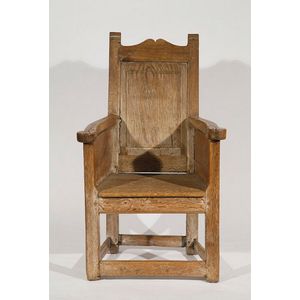Traditional Lambing Chair with Serpentine Top Rail
You must be a subscriber, and be logged in to view price and dealer details.
Subscribe Now to view actual auction price for this item
When you subscribe, you have the option of setting the currency in which to display prices to $Au, $US, $NZ or Stg.
- Serpentine - Resembling a serpent, in the form of an elongated 'S'. A serpentine front is similar to a bow front, except that the curve is shallow at each end, swelling towards the middle. The term presumably derives from its similarity to a moving snake or serpent. Serpentine fronts are usually veneered, with the carcase either being cut and shaped from a solid piece of timber, or built in the 'brick' method.
- Oak - Native to Europe and England, oak has been used for joinery, furniture and building since the beginning of the medieval civilisation. It is a pale yellow in colour when freshly cut and darkens with age to a mid brown colour.
Oak as a furniture timber was superceded by walnut in the 17th century, and in the 18th century by mahogany,
Semi-fossilised bog oak is black in colour, and is found in peat bogs where the trees have fallen and been preserved from decay by the bog. It is used for jewellery and small carved trinkets.
Pollard oak is taken from an oak that has been regularly pollarded, that is the upper branches have been removed at the top of the trunk, result that new branches would appear, and over time the top would become ball-like. . When harvested and sawn, the timber displays a continuous surface of knotty circles. The timber was scarce and expensive and was used in more expensive pieces of furniture in the Regency and Victorian periods. - Rail - A term used by cabinet makers for the horizontal sections of the frame of an item such as a chair or settee which have a front rail, a back rail and two side rails, and also on a door or carcase, where the rails are joined to the vertical framings.
This item has been included into following indexes:
Visually similar items

A 17th century English oak joined armchair with a diamond panelled back below a concave nulled frieze, above scroll arms and turned legs with cross stretchers, initialled Eb to apron and Js to back, right arm loose.

17th century oak and elm open arm chair carved top rail, plain panel back on baluster turned supports and legs

An Australian Arts & Crafts settee, influenced by Frank Lloyd Wright, circa 1905. 85 cm high, 137 cm wide and 58 cm deep

A set of eight Louis XIII style leather and oak chairs, late 19th to early 20th century, the square back chairs with shell form finials, leather back rests embossed with a trailing vine and grape motif above a series of spindles to the mid-rail, the side s
